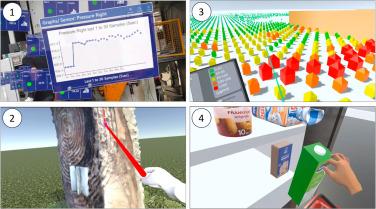Mastering the Future: Effective Training Strategies for Teachers Using VR/AR Tools
The digital revolution has accelerated change in nearly every industry, and education is no exception. Virtual Reality (VR) and Augmented Reality (AR) tools are transforming classrooms by making learning interactive, immersive, and more engaging. However, for these exciting technologies to reach their full potential, teachers must be equipped with the right skills and strategies. In this comprehensive guide, we’ll explore effective teacher training strategies for implementing VR and AR in education, along with real-world benefits, success stories, practical tips, and more. whether you’re a school leader, an educator, or a training coordinator, mastering the future of teaching starts here.
Why Invest in VR/AR Training for Teachers?
The integration of VR/AR technology in education is no longer futuristic—it’s happening now. From science labs to history tours, immersive tech has the power to boost student engagement, retention, and understanding. But technology is only as effective as the person using it. Well-structured VR/AR teacher training programs ensure that educators can confidently use these tools to deliver curriculum-aligned,student-centered lessons.
- Bridges the knowledge gap: Many teachers have limited exposure to immersive technologies, so targeted training demystifies the tools.
- Drives higher student outcomes: Properly trained teachers can design VR/AR experiences that are purposeful and tied to learning goals.
- Maximizes school’s investment: Empowered educators make full use of hardware and software resources.
- Prepares students for the future: Familiarity with emerging tech is essential in a rapidly evolving digital landscape.
Key Benefits of VR/AR in Teacher Training
Before diving into practical strategies, it’s vital to highlight the key benefits that VR and AR professional development brings to educators:
- Safe, Risk-Free Learning Environment: Teachers can practice new instructional methods without affecting real students.
- Enhanced Retention and Recall: Immersive experiences foster “learning by doing”—a proven way to boost knowledge retention.
- Personalized Learning: VR/AR platforms can provide tailored feedback and self-paced challenges for teachers.
- Collaborative Practice: Multi-user VR spaces simulate teamwork and classroom management scenarios.
for administrators, supporting AR and VR teacher training means fostering a culture of innovation and continuous growth.
Best Practices for Implementing VR/AR Teacher Training Strategies
Effective training goes beyond technical walkthroughs. Here are the most impactful strategies for training teachers to use VR/AR tools:
-
Start with the “Why”
- Begin training by explaining the advantages of VR/AR in teaching.
- Share practical use-cases (e.g., virtual field trips, interactive science labs, past reenactments).
-
Offer Hands-On Workshops
- Let teachers experience VR/AR environments as both learners and instructors.
- Practice lesson planning and classroom integration in a supported setting.
-
Provide On-Demand Learning Resources
- Host a library of video tutorials, FAQs, and troubleshooting guides.
- Offer digital sandboxes where teachers can experiment with lesson creation.
-
Promote Peer Learning and Collaboration
- Encourage teachers to share experiences and best practices during regular meetups.
- Create mentoring programs pairing tech-savvy educators with novices.
-
Integrate Feedback and Continuous Enhancement
- Gather feedback after training sessions to refine content and approach.
- Keep content updated with the latest VR/AR platform and software advancements.
-
focus on Pedagogy, Not Just Technology
- Discuss how VR/AR integrates with curriculum standards and differentiated instruction.
- Highlight classroom management within immersive environments.
Real-World Case Studies: VR/AR Teacher Training in Action
The theoretical benefits of VR/AR are impressive—but how does this look in practice? Here are a few case studies illustrating accomplished VR/AR teacher training.
Case study 1: Virtual Science Labs in Finland
A school district in Helsinki adopted a VR platform for science labs. Teachers were provided with a blended training program: online self-paced modules, followed by in-person workshops.as a result, teachers reported a 30% increase in confidence when using VR for biology and chemistry experiments, and students demonstrated improved engagement and test performance.
case Study 2: AR-Assisted Historical Tours in Texas
History teachers in a Texas school district received specialized AR training, using tablets and smartphones to conduct virtual museum tours. The district’s professional learning community fostered idea-sharing and lesson co-design, which led to wildly successful immersive history lessons and higher student details retention.
First-Hand Experience: A Teacher’s Journey into VR/AR Training
“When my school first introduced VR headsets for math and science, I was both excited and intimidated. Our professional development was hands-on: we put on the headsets, explored apps, and practiced guiding a lesson as a student would experience it. Peer support and ongoing Q&A sessions helped me grow.Now, I can’t imagine teaching without these immersive tools—they keep my students engaged and make learning unforgettable.”
Stories like these highlight the importance of supportive, well-designed VR/AR teacher training initiatives.
Practical Tips for Seamless VR/AR Integration in Teacher training
- Choose Accessible Tools: Begin with user-friendly VR or AR apps that align with your subject areas.
- Test in Advance: Allow educators to experiment with devices before rolling out in the classroom.
- Support multiple Learning Styles: Blend VR/AR with conventional methods for comprehensive engagement.
- Highlight Success: Celebrate teacher and student achievements with immersive tech to build momentum.
- Ensure Technical Support: Partner with IT teams or external consultants for ongoing troubleshooting.
Conclusion: Embrace the Future of Teaching with VR/AR
Mastering VR/AR tools in teacher training is not about replacing traditional teaching methods,but about enhancing them for a new generation of learners. As immersive technologies become more prevalent in education, schools that invest in effective, continuous, and practical teacher training will empower their educators and inspire students.Start today—so your staff, and your students, are prepared for tomorrow.
Want to learn more about building a successful VR/AR professional development program in education? Explore our in-depth resources, connect with our community, and take the first step into a profoundly exciting future for teaching and learning.

